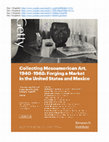Publications by Ellen Hoobler
Hollywood Arensberg, 2020
Louise and Walter Arensberg's modern art collection has been amply written about, but the rich gr... more Louise and Walter Arensberg's modern art collection has been amply written about, but the rich grouping of pre-Columbian art they formed has never been fully analyzed. This paper looks at the people and ideas that helped to shape this formative collection of pre-Columbian art in the United States.
Journal of the Walters Art Museum, 2018
Journal of Interactive Technology and Pedagogy , 2018
In Praise of Small Things: A Tribute to Diana Fane, 2018
Visual Culture of the Ancient Americas: Contemporary Perspectives, 2017
Contact me for full essay if interested
digitalzapotectombs.com, 2016
Xihuitl: le bleu eternel, 2011
El Futuro: Memoria del XXXI Coloquio Internacional de Historia del Arte. México: IIE, 2010
A nice introduction to Monte Albán and some of the issues and questions surrounding it. Good for ... more A nice introduction to Monte Albán and some of the issues and questions surrounding it. Good for undergraduate students.
Oaxacan Popular Arts in the New Millenium - catalogue of FOFA exhibition, 2008
American Indian Quarterly, 2006
Papers by Ellen Hoobler

The American Indian Quarterly, 2006
Today one of Mexico’s most popular tourist destinations is one that at first glance might not see... more Today one of Mexico’s most popular tourist destinations is one that at first glance might not seem of much interest to the casual traveler. The region surrounding the city of Oaxaca in southern Mexico has no beaches and no immense, American-style resorts. Yet tourists flock to it to experience the richness of Mexico’s Indigenous cultures, layered together from the present day back to pre-Columbian times, which can perhaps be experienced more intensely in Oaxaca than in any other place. Mexico was home to many Indigenous groups before the arrival of the Spanish in 1519, but in the ensuing years Indigenous people and their way of life have increasingly disappeared. The majority of Mexicans are, or consider themselves, mestizos, or racially mixed peoples of both Spanish and Indigenous descent. The controversy over Indigenous identity in Mexico is too complex to address in this article, so for the purposes of simplicity, Indigenous peoples are here defined as those who identify themselves as Indigenous and who, by and large, maintain cultural continuities with their pre-Columbian ancestors, such as fluency in pre-Hispanic languages, continuation in one form or another of ritual festivities, and in some cases, use of traditional garments. Oaxaca has the largest Indigenous population in Mexico, with about 36.6 percent of the population over five years old, or about 1.027 million people, speaking an Indigenous language. It has a wide diversity of people, with at least twelve ethnic groups within the state, each with its own language. The most widely spoken languages are the many (sometimes mutually unintelligible) dialects of Zapotec (spoken by approximately 350,000 people within the state) and Mixtec (spoken by approximately 250,000 people). It also has a rich variety in its ecological environment,
Teotihuacan: City of Water, City of Fire , by Matthew Robb, ed. Berkeley: University of Californi... more Teotihuacan: City of Water, City of Fire , by Matthew Robb, ed. Berkeley: University of California Press, in association with the Fine Arts Museums of San Francisco, 2017. 444 pages, 350 color illus. Hardcover $75.00. Reviewed by Ellen Hoobler. In 1973, the archaeologist Rene Millon published two
Conference Symposiums by Ellen Hoobler

The second international symposium of the Getty Research Institute's Pre-Hispanic Art Provenance ... more The second international symposium of the Getty Research Institute's Pre-Hispanic Art Provenance Initiative focuses on collecting practices in Mexico and the United States, when Hollywood luminaries and international collectors developed a taste for ancient Mexican art. By the 1960s, the pre-Hispanic past underpinned Mexican national identity, gained new audiences in international museums, and played a formal role in the history of art.
El segundo simposio internacional de la Iniciativa sobre la procedencia del arte prehispánico (PHAPI) del Getty Research Institute se centra en las prácticas del coleccionismo en México y de los Estados Unidos, cuando las luminarias de Hollywood y los coleccionistas internacionales desarrollaron un gusto por el arte mexicano antiguo. Para la década de 1960, el pasado prehispánico era parte integral de la identidad nacional mexicana, ganó nuevas audiencias en museos internacionales y jugó un papel formal en la historia del arte.











Uploads
Publications by Ellen Hoobler
Papers by Ellen Hoobler
Conference Symposiums by Ellen Hoobler
El segundo simposio internacional de la Iniciativa sobre la procedencia del arte prehispánico (PHAPI) del Getty Research Institute se centra en las prácticas del coleccionismo en México y de los Estados Unidos, cuando las luminarias de Hollywood y los coleccionistas internacionales desarrollaron un gusto por el arte mexicano antiguo. Para la década de 1960, el pasado prehispánico era parte integral de la identidad nacional mexicana, ganó nuevas audiencias en museos internacionales y jugó un papel formal en la historia del arte.
El segundo simposio internacional de la Iniciativa sobre la procedencia del arte prehispánico (PHAPI) del Getty Research Institute se centra en las prácticas del coleccionismo en México y de los Estados Unidos, cuando las luminarias de Hollywood y los coleccionistas internacionales desarrollaron un gusto por el arte mexicano antiguo. Para la década de 1960, el pasado prehispánico era parte integral de la identidad nacional mexicana, ganó nuevas audiencias en museos internacionales y jugó un papel formal en la historia del arte.